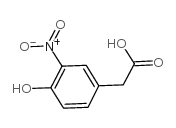2-(4-羟基-3-硝基苯基)乙酸

2-(4-羟基-3-硝基苯基)乙酸结构式

|
常用名 | 2-(4-羟基-3-硝基苯基)乙酸 | 英文名 | 4-Hydroxy-3-nitrophenylacetic acid |
|---|---|---|---|---|
| CAS号 | 10463-20-4 | 分子量 | 197.14500 | |
| 密度 | 1.435 g/cm3 | 沸点 | 302.9ºC at 760 mmHg | |
| 分子式 | C8H7NO5 | 熔点 | 146-148 °C(lit.) | |
| MSDS | 中文版 美版 | 闪点 | 137ºC | |
| 符号 |

GHS07 |
信号词 | Warning |
|
B cells in T follicular helper cell development and function: separable roles in delivery of ICOS ligand and antigen.
J. Immunol. 192(7) , 3166-79, (2014) B cells are required for follicular Th (Tfh) cell development, as is the ICOS ligand (ICOS-L); however, the separable contributions of Ag and ICOS-L delivery by cognate B cells to Tfh cell development and function are unknown. We find that Tfh cell and germin... |
|
|
A role for lysosomal-associated protein transmembrane 5 in the negative regulation of surface B cell receptor levels and B cell activation.
J. Immunol. 185(1) , 294-301, (2010) Mechanisms by which cell surface levels of the BCR are regulated remain largely unknown. We found that B cells lacking the lysosomal-associated protein transmembrane 5 (LAPTM5) expressed higher levels of cell surface BCR than did wild-type (WT) B cells after ... |
|
|
The pericyte and stromal cell marker CD248 (endosialin) is required for efficient lymph node expansion.
Eur. J. Immunol. 40(7) , 1884-9, (2010) CD248 is a cell surface receptor that specifically identifies fibroblasts and pericytes during development and in association with cancer and inflammation. However, its function is poorly defined and its role in lymphoid organs not studied. Here, we used (4-h... |
|
|
Early B blasts acquire a capacity for Ig class switch recombination that is lost as they become plasmablasts.
Eur. J. Immunol. 41(12) , 3506-12, (2011) Rapid production of neutralizing antibody can be critical for limiting the spread of infection. Such early antibody results when B-cell blasts mature directly to plasmablasts without forming germinal centers. These extrafollicular responses can involve Ig cla... |
|
|
Escherichia coli NsrR regulates a pathway for the oxidation of 3-nitrotyramine to 4-hydroxy-3-nitrophenylacetate.
J. Bacteriol. 190(18) , 6170-7, (2008) Chromatin immunoprecipitation and microarray (ChIP-chip) analysis showed that the nitric oxide (NO)-sensitive repressor NsrR from Escherichia coli binds in vivo to the promoters of the tynA and feaB genes. These genes encode the first two enzymes of a pathway... |
|
|
Intraclonal competition inhibits the formation of high-affinity antibody-secreting cells.
J. Immunol. 181(9) , 6027-37, (2008) Protective immunity requires a diverse, polyclonal B cell repertoire. We demonstrate that affinity maturation of the humoral response to a hapten is impaired when preexisting clonally restricted cells recognizing the hapten are dominant in the B cell repertoi... |
|
|
Quinoline-3-carboxamides modulate primary T cell-dependent B cell responses but do not inhibit functional immunity.
Scand. J. Immunol. 79(4) , 237-43, (2014) The effect of a quinoline-3-carboxamide on the T cell-dependent B cell response was investigated in C57BL/6 mice after NP-CGG immunization. The primary serum response to the hapten was slightly inhibited by treatment with a quinoline-3-carboxamide. This inhib... |
|
|
Correction of age-associated deficiency in germinal center response by immunization with immune complexes.
Clin. Immunol. 124(2) , 131-7, (2007) In aging, both primary and secondary antibody responses are impaired. One of the most notable changes in age-associated immune deficiency is the diminished germinal center (GC) reaction. This impaired GC response reduces antibody affinity maturation, decrease... |
|
|
The amino acid residue at position 95 and the third CDR region in the H chain determine the ceiling affinity and the maturation pathway of an anti-(4-hydroxy-3-nitrophenyl)acetyl antibody.
Mol. Immunol. 48(1-3) , 48-58, (2010) Two groups of anti-(4-hydroxy-3-nitrophenyl)acetyl (NP) Abs each possessing a different amino acid, Tyr or Gly, at position 95, appeared respectively at early and late stages of immunization. The early Abs predominantly harbored Tyr95 and were referred to as ... |
|
|
Nitric oxide regulates BAFF expression and T cell-independent antibody responses.
J. Immunol. 193(3) , 1110-20, (2014) Whereas NO is known to regulate T cell responses, its role in regulating B cell responses remains unclear. Previous studies suggested that inducible NO synthase 2 (NOS2/iNOS) is required for normal IgA Ab responses but inhibits antiviral IgG2a Ab responses. I... |